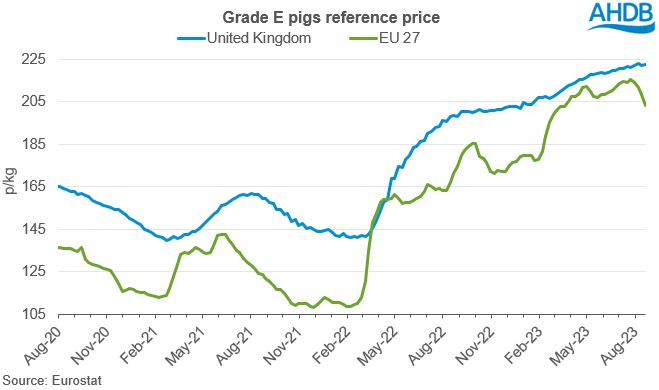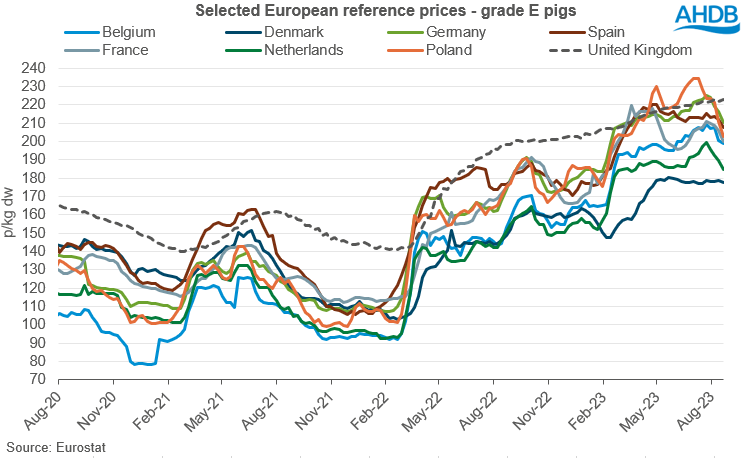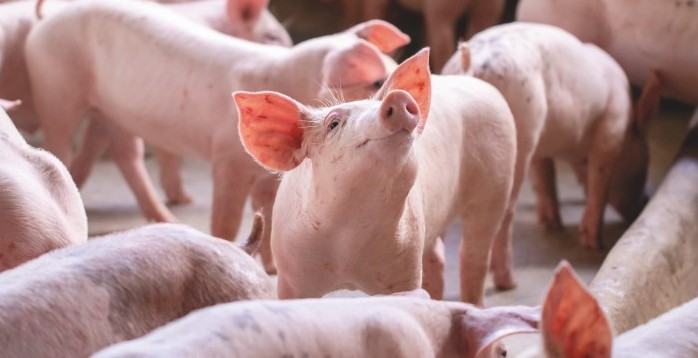The differential between EU and UK pig prices has returned to more typical levels, after weeks of falling prices on the continent.
Since peaking at the record high of 215.47p/kg in the penultimate week of July, the EU reference prices has been in steady decline, losing just over 12p/kg in four weeks.
“Pig kill remains low in the EU, suggesting the drop in prices is predominantly driven by easing demand. There have been some reports of over supply on the continent, as unfavourable summer weather in some regions has limited the BBQ market,” said AHDB analyst Freya Shuttleworth.
Higher pig prices have also been driving up the unit value of exported product. This has resulted in the differential between the EU reference price and the UK reference price increasing to 19.5p/kg in the week ending 20 August, compared with just 6p for the week ended July 23.

“This is a return to more normal trends that we have seen over the last couple of years, with the price difference in recent months trending at historical lows,” Ms Shuttleworth added.
The rate of decline has been mixed across the region. Belgium, France, Germany and the Netherlands have all lost between 10–15p/kg in the four weeks ending August 20, with the most significant changes being recorded in the final week. Spain has seen slightly smaller movements, with prices moving downwards just shy of 8p in the last four weeks – over 4p of this occurred in the most recent week.
The largest price decline has been recorded in Poland, where prices have fallen by 20.7p over the period (July 23 – August 20). Polish pig prices have been falling for seven consecutive weeks having peaked in early July.
Meanwhile, Danish pig prices have been relatively flat since the beginning of June, only dipping by 1.3p/kg over the reporting period.
 “Pig producers on the continent have been suffering similar financial pressures to those in the UK, due to the input cost inflation skyrocketing last year,” Ms Shuttleworth said.
“Pig producers on the continent have been suffering similar financial pressures to those in the UK, due to the input cost inflation skyrocketing last year,” Ms Shuttleworth said.
“The cost of key inputs has eased in recent months, relieving some of the pressure on farm margins, however costs are likely to remain historically high for the foreseeable with the global economy recovering after COVID-19 and geopolitical tensions continuing to run high.
“This also impacts processors as many of their running costs have substantially increased – pair this with lower kill volumes and margins are tightened. This has led to some large adjustments in the structure of the industry, such as abattoir closures.”
UK Impact
She added: “There are some concerns that the UK market will start to follow the price trends seen in the EU, which are not unjustified with the two markets very closely connected.
“However, it appears that the UK market may be more balanced. Supplies remain tight and demand seems to be holding up, although purchased volumes vary by product, with the peak pork demand period of Christmas still a little way off.
“But lower EU prices does increase the competitiveness of the region’s exports. If UK prices remain steady, easing EU prices could attract more import demand, both domestically here in the UK and from elsewhere in the world.
“A key factor will continue to be supply, with EU production forecast to end 2023 down year-on-year for the second consecutive year. This may limit EU value declines, especially when compared with key international producers such as the USA and Brazil, who currently have prices well below the EU and UK.”




